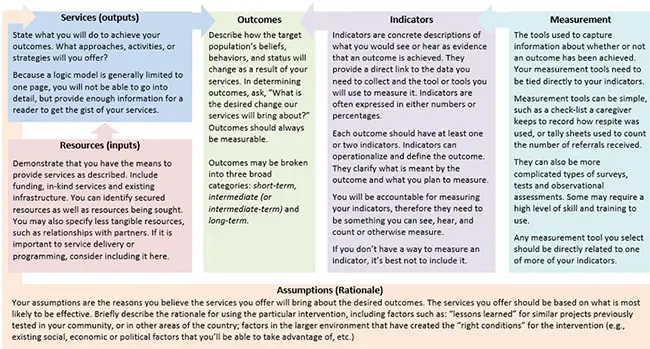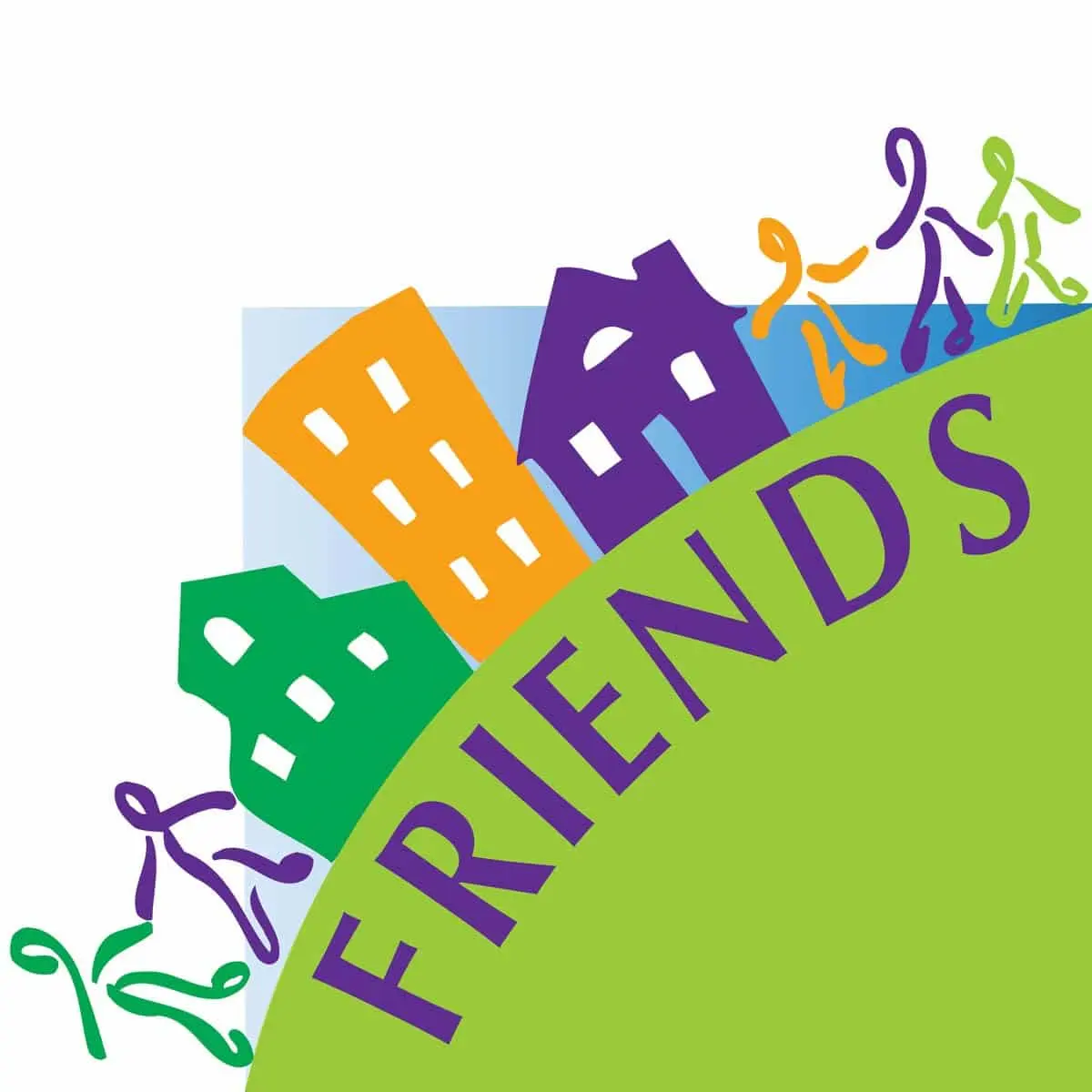Logic Models
What is a Logic Model?
A logic model is a map of your program. It is a simple, logical illustration of what you do, why you do it, and how you will know if you are successful. There is a wide variety of logic model formats, but most have the same key components. The elements of a logic model will become more apparent as you go through the logic model building process. Although the process is laid out in a step by step fashion, you will find the need to “loopback” to make certain decisions made in later phases still match choices you made earlier.
Ideally, someone unfamiliar with your program should be able to pick up your one-page logic model and have a general understanding of the linkages between the services you provide and the desired outcomes you hope will be achieved.
Logic Model Components
What is a Vision Statement?
Begin the process of building a logic model with a statement that encapsulates the driving force behind the work you do. What do the families in your community want and value? What do you want for the families and community that you serve? Knowing and articulating the purpose behind your efforts will help keep you on course.
A truly inspired vision statement may not be measurable, at least not in the short-term, and your program doesn’t necessarily have to be responsible for single-handedly achieving it. Instead, your program may be contributing to its achievement. What is important is that your vision statement has meaning and is a true reflection of the spirit behind your actions.
Vision statements can be very diverse. Some examples are:

The vision statements in the above examples are ambitious. A 12-week parent education program cannot expect to have “all children ready for school by 6,” but if the program is successful, it should contribute to the vision of having all children ready for school by 6.
Most importantly, all policies and practices should be consistent with your vision.
What is a target population?
The term “target population” refers to the people your program is designed to serve. For your program’s logic model, you will identify the people who will receive your services, being as specific as possible. Examples include “parents living in our county with a child under three,” “all parents of children with disabilities living in our town,” and “parents referred by CPS due to risk of out-of-home placements.”
What are the population needs?
What are the participants’ needs that this program intends to address? What social issue will your services help mitigate? Example; “We serve newly arrived immigrant families who are unfamiliar with the laws and customs in the United States. We recognize their need to understand the social, educational, and medical services available to their families and the laws that are related to parenting.”
Families already participating in your program are the best source of information about their own needs and aspirations. Be sure to reach out and listen to their ideas as you draft this section of the logic model. A parent leader serving on your logic model design team could also offer valuable insights into population needs.
Where can I find more information on target populations and population needs?
FRIENDS has developed a resource on target population and population needs, to view this information, click here.
What are resources?
Resources are what your program needs to run its activities or provide services. Some logic models refer to this section as “inputs”. What will you need to put into the program to make it run?
At any point in the process of developing a logic model, you may need to loop back and rethink previous steps. As you work through this section of your logic model, you may decide you do not have the resources necessary to provide services, and decisions will need to be made. Do you need to seek more funding? Serve fewer families? Select different services?

These are the type of questions you will ask when completing this section of the logic model. On a separate sheet of paper, make a list of everything that is needed to provide the services you have selected. Indicate the cost of each item and whether or not you have secured the funding for it.
No doubt, your list will be too long to fit neatly into a one-page logic model. Eventually, you’ll need to collapse it into manageable categories for that purpose, but the exercise is invaluable. Do you have the resources you need to provide services with fidelity to the model you have chosen? If not, can you get them?
At any point in the process of developing a logic model, you may need to loop back and rethink previous steps. As you work through this section of your logic model, you may decide you do not have the resources necessary to provide services, and decisions will need to be made. Do you need to seek more funding? Serve fewer families? Select different services?
How do I organize the resources section?
You may want to identify the resources already secured as well as the resources that are being sought. You may also want to use this section to specify less tangible resources, such as relationships with partners. If it is essential to the delivery of services or programming, you should consider including it here.
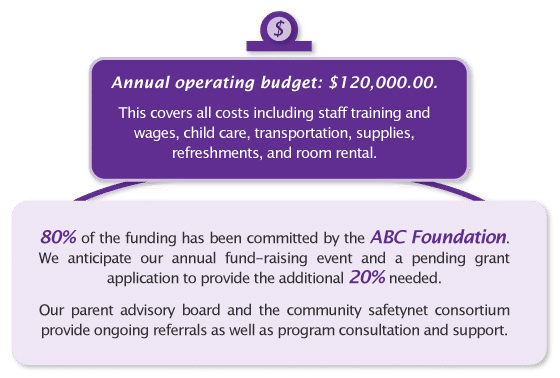
What is the services section of a logic model?
This is the section of your logic model where you briefly identify the services you will provide that should lead to the targeted outcomes. Describe the approaches, program, or strategies you will offer that are designed to achieve your identified outcomes.
For example, if you are offering a particular program model, such as Parents as Teachers, you would name it and include information about how often its various program components, such as home visits or group sessions, will be offered over what time periods. Other examples could be “weekly parent education groups using the Families Together curriculum”, “bi-monthly home visits by maternal child health nurses”, etc. Below is another example:
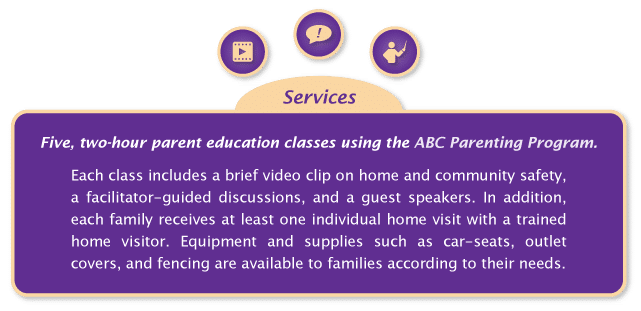
How should programs begin to determine the services they provide?
While innovation in designing services to fit your families and communities is encouraged and commended, you need not start at zero. A body of research exists to guide our practice.
In choosing prevention strategies, look for services that have the most and best evidence that they produce positive changes for children and families. FRIENDS has numerous resources related to the research behind various programs. A good overview is available at Evidence-Based Practice in CBCAP.
Roberts and Yeager (2004), in their book on evidence-and practice-based research, urge practitioners to use “scientifically validated assessment, intervention and evaluation procedures, and…use critical thinking when making practice decisions”.
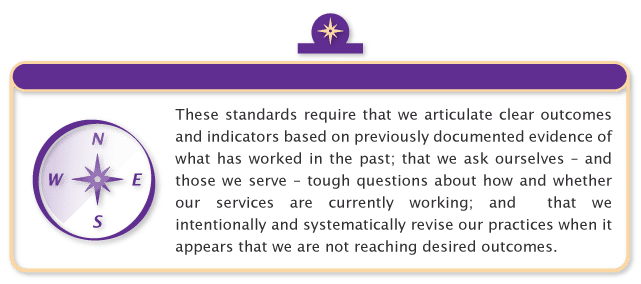
*“Evidence-Based Practice Manual” (p.5), A.R. Roberts and K.R. Yeager (Eds.). Oxford University Press, (2004).
Always chose services and strategies that have the most and best evidence that they produce positive changes for the population you serve.
What are assumptions?
Your assumptions are the reasons you believe the services you offer will bring about the desired outcomes. What does the research say about your program or the approach you have selected?
The services you offer should be based on what is known to be effective. A term for this is evidence-informed or evidence-based, meaning that you have made decisions based on what is known to be effective.
A significant source of this knowledge is in the research literature. If your approach is innovative and unproven, the assumptions you articulate should provide insight into why you think it will work. Any informed guesses you are making about the major factors that will influence your program’s effectiveness should be included in your logic model.
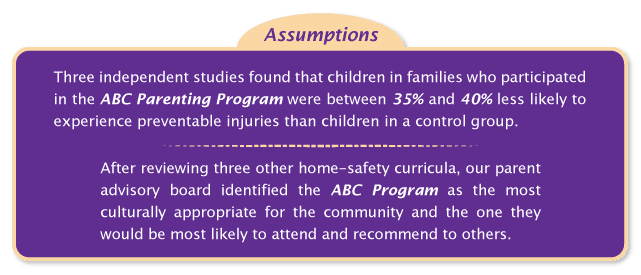
If you are uncertain of the empirical foundations of your approach, now is the time to stop and investigate what works. You will often want to loop back and rethink previous steps in developing your logic model. For example, as you examine your assumptions, you may find that the services you have identified are not appropriate for the population you serve, or your services have not been demonstrated effective. You may decide to alter your logic model as you learn more about what is effective.
Where can I find research on evidence-based practice in prevention programs?
If you have reached this point in your logic model and you have not investigated whether or not your approach is evidence-based or evidence-informed, now is the time to stop and conduct that research. Check out the Evidence-Based Practice in CBCAP page. Another good starting point is the Child Welfare Information Gateway web site, which contains numerous resources on evidence-based practices.
TIP: There probably will not be space in your logic model to describe all assumptions or state the complete details of your services. However, those details should be spelled out elsewhere, either in the text of a grant application or in your program’s work plan or evaluation plan.
What are outcomes?
Outcomes are statements about the changes in status, beliefs, and behaviors that your services are designed to bring about. If you are successful in providing your services, what changes will program participant’s experience? You will be accountable for the outcomes you identify, which means outcomes need to be measurable.
Outcomes are generally divided into three broad categories: short-term, intermediate, and long-term. Although the categories suggest timeframes, and some logic models use them that way, the terms are relative. For example, a program lasting six months may view six weeks as short-term, whereas a program lasting six weeks may consider the same amount of time as long-term.
You may decide to group your outcomes according to timeframes, for example, you may designate as short-term the outcomes that occur during the first three weeks of service. But there is another way to define the categories. You can determine if an outcome is short-term, intermediate, or long-term based on the type of change expected. Think of it this way:
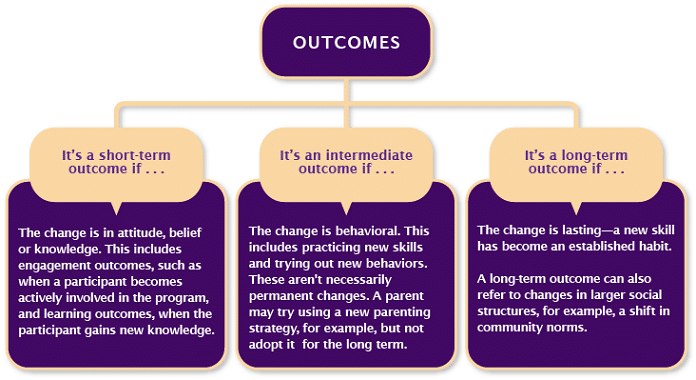
What are some examples of outcomes?
Generally, outcomes describe who → will do → what as a result of your services. Outcomes can look very different, but some examples of outcome statements are:
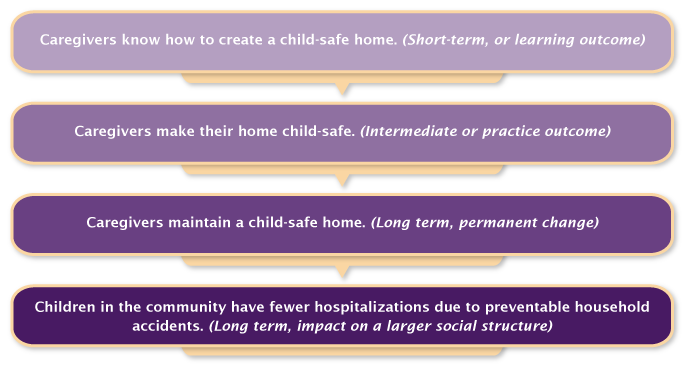
Notice the progression in the above examples. First, the caregiver learns how to create a child-safe home, then they make modifications to their home, and finally, they maintain a safe home. Eventually, with enough caregivers providing safe homes for children, the entire community sees a drop in preventable household accidents.
Keep in mind that you should never use outcomes that aren’t measurable. Depending on how long you maintain contact with the people you serve, you may never be able to measure the long-term outcomes. Following the examples above, if you served families for only a few months, you might only be able to measure the short-term and intermediate outcomes. You may believe that your services will lead to the long-term outcomes, but if you can’t track the families to measure those outcomes, leave the outcomes off your logic model.
Where can I find outcomes that my program can adapt?
FRIENDS has created a menu of outcomes that are targeted by prevention programs. You can view the menus by clicking here. You can also see them as a component of the Logic Model Builder. If you choose to build a logic model using our Logic Model Builder system, you will also be able to search outcomes and indicators by keywords and construct.
TIP: The toolkit menu of outcomes and indicators has extensive lists of outcomes. There should be some that are appropriate for your program, but you will want to edit, so the statements are accurate reflections of what your services target. In other words, please don’t “pick and click” and stop there.
Where can I find more information on outcomes?
FRIENDS has developed a resource on outcomes. Click the link to download this resource.
What are indicators?
Indicators answer the question, “What would I see or hear that would tell me that an outcome was achieved?” Indicators are concrete, specific descriptions of what you will measure. Below is an example of what some indicators might look like. Notice how indicators can operationalize and define the outcome — they clarify what is meant by the outcome and what you plan to measure.

What does the term “performance target” in indicators mean?
The performance target allows you to quantify or add numbers to indicators. When you define the amount of change you expect in a specific timeframe, you are setting what are called “performance targets.”
An indicator can include a specific performance target; that is, the number or percentage of participants projected to achieve it. Let’s see what this might look like:

Be thoughtful about setting your targets, as you won’t want them to be too ambitious or too easy to reach. To learn more about performance targets, click here.
Additionally, when you set indicators, remember you will need to measure them—they need to be items you can see or hear. For indicators 1 and 2 (above), you might be able to see a list of rules or a diary a parent keeps on her child’s behavior. Indicators 3 and 4 are trickier. You will need to either see them happening, say in a playgroup, or a home visit, or you may need to rely on parent self-report. If you don’t have a way to measure an indicator, it is best not to include it.
Where can I find sample indicators my program can adapt?
FRIENDS has created a menu of outcomes and indicators targeted by prevention programs. You can view the menus by clicking here. You can also view them as a component of the Logic Model Builder. If you choose to build a logic model using the Logic Model Builder system, you will also be able to search the outcomes and indicators by keywords and construct.
Tip: The toolkit menu of outcomes and indicators has extensive lists of indicators. There should be some that are appropriate for your program, but you will want to wordsmith and edit so that statements are accurate reflections of what your services target. In other words, please do not “pick and click” and stop there.
Where can I find more information on indicators?
FRIENDS has developed a resource on indicators; click here to view.
What are Measurement Tools?
Measurement tools capture information about whether or not an outcome has been achieved.
| They can be simple, such as check-lists that a parent can keep to record daily reading with children, appointments kept with counselors, household safety precautions present in the home, etc. |
| They can also be more complicated types of surveys, tests, and observational assessments. Some may require a high level of skill and training to use. Any program, regardless of its size or budget, should be able to find a way to measure outcomes. |
Any measurement tool you select should be directly related to one or more of your indicators. Let’s see how this works.

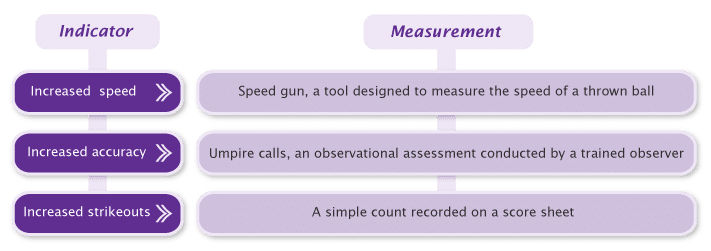
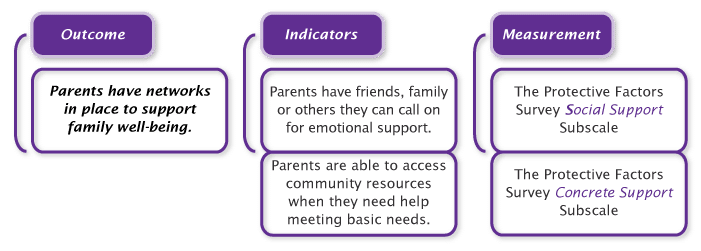
The costs of measurement tools vary greatly, but many are in the public domain.
Choose measurements carefully to make sure they accurately measure the indicators you have set and that you have access to the data needed to use the tool. Find out what tools similar programs have used; ask others about their experiences using them. To begin exploring some measurement tools in use by prevention programs, visit Compendium of Annotated Measurement Tools.
What else should I consider when selecting measurement tools?
An instrument’s reliability and validity need to be considered before deciding to use it. Simply put, when the results yielded from a given tool are consistent, then the tool is deemed to be reliable. A tool’s validity is related to whether or not it measures what it’s supposed to measure. It is possible the results of your evaluation won’t be considered credible unless the tools chosen to measure your outcomes have high levels of reliability and validity documented.
To learn more about reliability and validity, FRIENDS has developed a resource on common measurement tools and methodology: Selection And Use Of Measurement Tools.
An excellent source of information about measurement tools is the California Clearinghouse on Evidence-Based Programs. It includes a directory of measurement tools with established validity and reliability.
What should I do if I can’t locate or access an appropriate measurement tool?
You may find that you need to create your own tools. FRIENDS has developed a publication on Constructing Rating Scales, which may also be helpful in understanding questionnaire and scale design.
What are the first steps in logic model development?
Identify a team with members who represent the stakeholders in your program. Teams should include parent-leaders, direct service staff, and administrators. Because a logic model guides program development, implementation, and evaluation, those people who will be affected by it should also be involved in creating it. Your team can go with you through each step of the logic model development process, or they can review work already completed. The team can make recommendations, review the literature, and provide valuable insight into what is both positive and possible in your work with children and families.
FRIENDS has developed several resources to guide you in preparing your own logic model.
- Blank Logic Model Template
- A searchable database of Outcomes and Indicators
- A Compendium of Annotated Measurement Tools that is searchable and linked to potential outcomes/indicators
- Detailed information on Logic Model construction including a breakdown of various components and in-depth resources
- Online learning course in Logic Models
TIP: The CBCAP program operates from a logic model, called the CBCAP Conceptual Framework.
Where can I see other logic model formats?
There is no right or wrong logic model design. Below are links to some other logic model formats.
The following annotated logic model uses the components described here:
The Title of Your Project
Vision (impact, long-term outcome, goal): Your vision statement is a reflection of the purpose and spirit behind your actions. All activities and outcomes should contribute to the achievement of your vision. A truly inspired vision statement may not be measurable in the short-term, and your program doesn’t necessarily have to be responsible for single-handedly achieving it. Rather, your program may be contributing to its achievement.
Population and Population Needs: A description of the population you are targeting and the specific needs you intend to address through your services.
